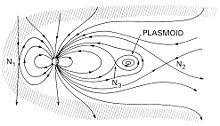Plasmoide
Um plasmoide é uma estrutura coerente de plasma e campos magnéticos. Plasmoides foram propostos para explicar fenômenos naturais tais como raios globulares,[1] bolhas magnéticas na magnetosfera,[2] e objetos em rabos de cometas,[3] no vento solar,[4][5] na atmosfera solar,[6] e na camada heliosférica difusa.

Referências
- ↑ Silberg, Paul A., "Ball Lightning and Plasmoids", (1962) Journal of Geophysical Research, Vol. 67, p.4941
- ↑ Hones, E. W., Jr., "The magnetotail - Its generation and dissipation", (1976) Physics of solar planetary environments; Proceedings of the International Symposium on Solar-Terrestrial Physics, Boulder, Colo., June 7-18, 1976. Volume 2.
- ↑ Roosen, R. G.; Brandt, J. C., "Possible Detection of Colliding Plasmoids in the Tail of Comet Kohoutek" (1976), Study of Comets, Proceedings of IAU Colloq. 25, held in Greenbelt, MD, 28 October - 1 November, 1974. Edited by B. D. Donn, M. Mumma, W. Jackson, M. A'Hearn, and R. Harrington. National Aeronautics and Space Administration SP 393, 1976., p.378
- ↑ Lemaire, J.; Roth, M., Differences between solar wind plasmoids and ideal magnetohydrodynamic filaments Planetary and Space Science, Volume 29, Issue 8, p. 843-849
- ↑ Wang, S.; Lee, L. C.; Wei, C. Q.; Akasofu, S.-I., A mechanism for the formation of plasmoids and kink waves in the heliospheric current sheet (1988) Solar Physics (ISSN 0038-0938), vol. 117, no. 1, 1988, p. 157-169.
- ↑ Cargill, P. J.; Pneuman, G. W., "The energy balance of plasmoids in the solar atmosphere" (1986), Astrophysical Journal, Part 1 (ISSN 0004-637X), vol. 307, Aug. 15, 1986, p. 820-825.